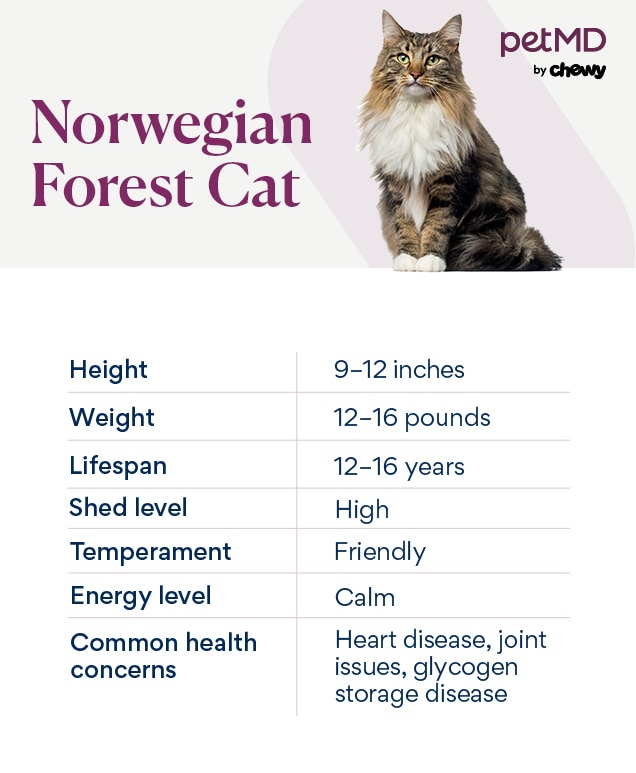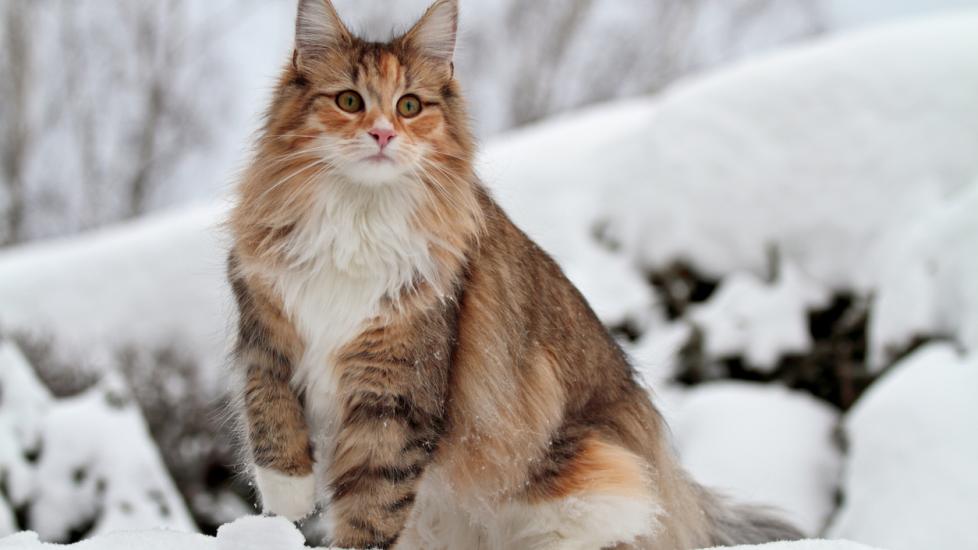Norwegian Forest Cat
The playful Norwegian Forest Cat is a large, muscular, friendly cat that typically weighs 12–15 pounds, with some caveats: Mature females can be as small as 8 pounds, while some males can get up to 19 pounds or more.
Known as the Wegie (pronounced “wee-gee”) by breed aficionados and as skogkatt (meaning “forest cat”) in Norway, where the breed is the country’s official feline, this cat has a rich history dating back to the time of the Vikings, when they were kept on ships to keep the rodent population down. In fact, Norse oral histories include tales of large cats with excellent climbing skills, and Wegies are believed to be the mythical cats of the Norse gods (including Freyja, who is said to have driven a chariot pulled by two of these cats).
Caring for a Norwegian Forest Cat

The Norwegian Forest Cat is larger than your average domestic feline, but he’s a true gentle giant that befriends everyone he meets, while still maintaining his independence.
Wegies tend to be quite loyal, often devoting themselves to one member of the family (but wanting to be adored by all), says Donna Armel, the breed chair for the Norwegian Forest Cat with The International Cat Association (TICA). A licensed Allbreed Cat Judge for TICA, she’s been breeding and showing Wegies for 20 years and describes them as extremely intelligent, resourceful, and mild-mannered, and at the same time playful and interactive.
Armel says the breed’s semi-long coat requires weekly combing, so potential pet parents should be prepared to take on those grooming duties; heavy seasonal shedding may require additional efforts. Having tall cat trees available is important because this breed loves to climb and perch, and with the Norwegian Forest Cat’s size, make sure any surfaces he’ll be jumping on will hold his weight.
Because of their origins as a true hunter, Norwegian Forest Cats love pouncing and practicing their natural hunting skills with mouse-like toys or feather wands. He might even patrol his territory to ensure everything is in order.
Norwegian Forest Cat Health Issues
The Norwegian Forest Cat, which is a natural breed (meaning it was not created by humans crossing any other cat breeds) tends to be healthy, with an impressive lifespan up to 20 years. However, there are a few potential health issues pet parents should be aware of.
Hypertrophic Cardiomyopathy (HCM)
“This is a common heart disease within most feline breeds, so Norwegian Forest Cats are no exception,” says Paula Simons, DVM, an emergency and critical care veterinary resident at Cornell University Veterinary Specialists. “This disease is characterized by thickening of the heart muscle (hypertrophy). As the disease progresses, the heart fails to pump effectively, leading to congestive heart failure. As the heart becomes thicker, cats may be prone to blood clots that can be fatal.”
Symptoms can include loss of appetite, lethargy, and difficulty breathing. Your veterinarian may use an EKG, X-ray, and/or ultrasound for diagnosis, and a cat suffering from this heart disease might be hospitalized for immediate care and placed on lifelong medications.
Hip Dysplasia
Hip dysplasia is a condition where the hip joint doesn’t develop properly, leading to a loose joint and, if left untreated, arthritis. Symptoms include discomfort and limited mobility, so you might notice your cat limping, bunny hopping, or not jumping up.
While the condition can be managed with anti-inflammatories and pain medication, severely affected cats may need surgery, Simons says. A physical exam and X-rays will help your veterinarian diagnose hip dysplasia. Joint supplements are often helpful to protect your cat’s joints from damage.
Glycogen Storage Disease
This rare inherited disease, which is also known as glycogenosis, leads to abnormal glucose metabolism, Simons explains. “This leads to an inability to produce energy, leading to weakness, lethargy, muscle loss, and even death,” she says. “Many kittens with this disease may be stillborn or die before 5 months of age. Unfortunately, there is no known treatment.”
Cats with this disease have a shortened life expectancy and generally live about four years. For cats that survive past kittenhood, symptoms may include fever, muscle tremors, and weakness. There are a number of ways your veterinarian may diagnose the condition, including a tissue enzyme analysis, urine analysis, genetic testing, and electrocardiography.
What To Feed a Norwegian Forest Cat
Wegies don’t have special dietary needs, says Simons, other than to ensure they are fed an AAFCO (Association of American Feed Control Officials) approved cat food appropriate for their life stage.
You might also consider feeding your cat a mix of wet food to help them stay hydrated and dry food to help remove tartar from their teeth.
How To Feed a Norwegian Forest Cat
Choose a food appropriate for your Wegie’s life stage (kitten, adult, or senior), and feed him a measured amount appropriate for his size two or three times a day. Aside from those standard guidelines, there aren’t special considerations regarding the breed’s feeding.
However, when it comes to their life stage, keep in mind that Wegies mature slowly, reaching full-grown status around their fifth birthday. Talk to your Norwegian Forest Cat breeder and your veterinarian about when your cat should switch from kitten to adult food.
How Much Should You Feed a Norwegian Forest Cat?
Because the Norwegian Forest Cat size is so large, they need to eat more than smaller cats. Use the label and serving suggestions on your cat food packaging as a guide, then adjust as needed.
Take care not to free-feed or overfeed your Wegie to prevent him from becoming overweight or obese, which can be especially problematic given the breed’s propensity toward hip dysplasia.
Nutritional Tips for Norwegian Forest Cats
Because Norwegian Forest Cats can develop hip dysplasia, talk to your veterinarian about whether your cat can benefit from a joint supplement.
Behavior and Training Tips for Norwegian Forest Cats
Norwegian Forest Cat Personality and Temperament
Affectionate, loyal, bright, and playful, the Norwegian Forest Cat matures slowly, maintaining a kitten-like demeanor until they’re about 5 years old. They don’t demand attention, but they do want to be friends with everybody they meet. So even though they’re quite large, they’re wonderful choices for families with children or other pets.
As long as they’re given adequate love, attention, and opportunities to climb and play, Norwegian Forest Cats are quite adaptable to all kinds of people and surroundings. The one thing they don’t adapt to so well, though, is hot weather due to their thick fur.
Norwegian Forest Cat Behavior
Although they’re generally quiet (offering only an occasional chirp) and laid-back, the Norwegian Forest Cat loves to be loved, so they’re happiest when they’re part of a family who is ready to give them the attention they deserve.
Separation anxiety can be an issue if they’re left alone frequently for long periods—they love their people so much—but they’re easygoing enough that they can typically handle a bit of alone time without any trouble. Consider using a calming probiotic to help ease their anxiety.
As incredibly adept climbers with exceptionally strong hind legs, Wegies can reach heights you might assume to be off-limits. Secure tall cabinets or shelves so your Norwegian Forest Cat can safely explore—because they will find a way to jump up there.
Norwegian Forest Cat Training
The clever Wegie is a fairly trainable cat that should easily pick up on the basics, like using the litter box. Just make sure the litter box is big enough for this sizeable feline!
Clicker training is absolutely a possibility because they’re so intelligent and eager to spend time with their family, so don’t hesitate to work with them on tricks. They may also take well to walking in a harness, especially if it means they get to explore with you. After all, they did originate in the forest!
Fun Activities for Norwegian Forest Cats
-
Climbing cat towers, cat shelves, and any other high-up places
-
Playing with toys
-
Spending time with family
-
Learning tricks
Norwegian Forest Cat Grooming Guide
The Norwegian Forest Cat’s thick, dense coat is water-repellant and designed to protect him from harsh Scandinavian winters. To prevent mats, it requires regular combing and brushing—at least once a week, says Armel. In the spring, and again in the fall when they shed more heavily, you’ll likely need to increase your grooming efforts to several times a week to keep up.
“Like all cats, they will benefit from routine nail clipping to prevent their nails from growing into their paw pads,” Simons says. This can be tricky due to the tufts of fur (referred to as “snowshoes”) on their feet. If you teach your Norwegian Forest Cat kitten that this is a fun time to bond and not a chore to dread, you should have no trouble.
Coat Care
“The breed has a water-repellent, semi-long coat with a dense undercoat, which helped them survive the cold winters of their native land,” Armel says. “This coat will require combing on a weekly basis. But really, they’re a very easy cat to keep looking good.”
It’s not just about looks, though: Regular combing is the key to preventing mats, which can become painful and require professional help to remove.
Eye Care
No special eye care is required for Norwegian Forest Cats, but if you notice changes in your pet’s eyes (such as redness or discharge), consult your veterinarian.
Ear Care
If you notice odor, debris, or redness in your Wegie’s ears, talk to your veterinarian to make sure your cat doesn’t have an ear infection.
Considerations for Pet Parents
The Norwegian Forest Cat is a wonderful, family-friendly cat, says Simons. They adapt easily to many homes and living situations, and, while they’re highly social, they’re also known to be independent, preferring to come and go rather than cuddle in a lap all day long.
Wegies have moderate to high exercise requirements and need towers and secure shelving to climb. Otherwise, they’ll find their own way to elevated perches—and might not take your preferred path. Norwegian Forest Cats don’t tend to love hot weather due to their thick coat, so if you live somewhere warm, be sure they have ways to avoid the heat and cool off, Simons says.
Norwegian Forest Cat FAQs
How much does a Norwegian Forest Cat cost?
Typical Norwegian Forest Cat prices start at $1,000 and climb to “many thousands for a show-quality kitten, depending on their pedigree,” says Armel.
How much does a Norwegian Forest Cat weigh?
The typical female Norwegian Forest Cat will weigh 8–10 pounds, while males can weigh 15–19 pounds or more.
What’s the difference between a Norwegian Forest Cat vs. a Maine Coon?
The Norwegian Forest Cat’s distinctive bushy tail and dense, water-resistant coat draws plenty of comparisons to the Maine Coon. But Wegies tend to be a bit smaller, more slender, and have more of an almond shape to their eyes than Maine Coon cats.
Featured Image: iStock/undefined undefined
